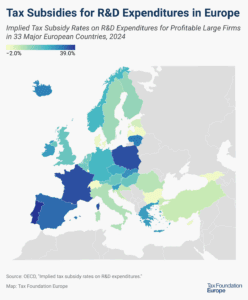
Tax Reform in the UK Reversed the Tide of Corporate Tax Inversions
12 min readBy:Key Findings
- The United States is not the only country to experience the phenomenon of corporate taxA tax is a mandatory payment or charge collected by local, state, and national governments from individuals or businesses to cover the costs of general government services, goods, and activities. inversions.
- Despite cutting the corporate tax rate from 52 percent in 1980 to 28 percent by 2008, the UK levied one of the higher corporate tax rates in Europe and operated under one of the few remaining worldwide tax systems.
- As a result of the high rate and worldwide tax systemA worldwide tax system for corporations, as opposed to a territorial tax system, includes foreign-earned income in the domestic tax base. As part of the 2017 Tax Cuts and Jobs Act (TCJA), the United States shifted from worldwide taxation towards territorial taxation. , many British companies left or announced plans to “invert”; the UK faced an “exodus of British companies fleeing the tax system.”
- In response, the UK government implemented both a territorial tax systemTerritorial taxation is a system that excludes foreign earnings from a country’s domestic tax base. This is common throughout the world and is the opposite of worldwide taxation, where foreign earnings are included in the domestic tax base. and a series of corporate tax reforms that will lower the corporate tax rate from 28 percent in 2010 to 20 percent in 2015.
- After these changes, UK corporate inversions reversed, and many American companies now aim to move to the UK. Further, the total number of UK corporations has grown to 1.1 million as of 2012, and it is on track to overtake the U.S. in number of corporations by 2017.
- Lawmakers in the U.S. would do well to follow the British example on corporate inversions by lowering our corporate tax rate—the third-highest in the entire world—and replacing our worldwide tax system with a modern territorial system.
Introduction
There is a common perception in the United States that corporate “inversions” are a problem unique to the U.S. and, thus, require a uniquely American solution. Indeed, the Treasury Department recently issued a series of unilateral measures intended to remove some of the purported financial benefits of such transactions.[1]
However, the United Kingdom, one of our largest trading partners, went through a similar experience less than a decade ago and initiated a program of tax reforms—including lowering the corporate tax rate and moving to a territorial system—that not only stemmed their inversion problem, but also greatly improved the competitiveness of the UK’s corporate tax system. Indeed, the UK corporate tax climate is now so attractive that some American companies are seeking to move their headquarters there.
The United Kingdom’s experience should provide not only a lesson for U.S. lawmakers, but also a roadmap for how to make the U.S. a more competitive place to do business in and from.
The UK Experience
For many years, the United Kingdom maintained a corporate tax regime that looked very similar to that of the United States. Figure 1 shows that in 1980, the U.S. and the UK both levied corporate tax rates higher than the average rate imposed by developed nations in the Organization for Economic Cooperation and Development (OECD). The UK rate was 52 percent, while the U.S. rate was 46 percent at the federal level (50 percent including the average state rate). Moreover, the UK had a worldwide tax system similar to that of the U.S., which meant that the domestic and foreign earnings of a multinational corporation were taxed at the same rate, subject to a credit for taxes paid to another country.
By all accounts, the Thatcher administration launched the global corporate tax race when it repeatedly cut the British corporate tax rate from 52 percent in 1980 to 35 percent by 1986. The Reagan administration and Congress followed suit with the Tax Reform Act of 1986, which cut the U.S. federal corporate tax rate to 34 percent. The U.S. federal rate was subsequently raised to 35 percent in 1993 where it has remained ever since.
Following the example of these two countries, virtually every other developed nation began aggressively cutting corporate tax rates, lowering the unweighted OECD average from 48 percent in 1985 to 25 percent today.
While the UK continued to make small cuts to its corporate tax rate over the next two decades, by 2008, the UK had fallen behind the competition and levied one of the higher rates in Europe. The Labour government lowered the corporate tax rate from 30 to 28 percent, but many European countries had lowered theirs even further, particularly Ireland with its 12.5 percent corporate tax rate.
Additionally, the UK still operated a worldwide tax system, which meant that UK-based multinational corporations had to pay UK corporate tax on their foreign earnings. This was increasingly rare at the time, as most European countries had switched to territorial taxation, which limits corporate taxation to profits earned domestically. Further, the Labour government was threatening to increase taxes on foreign earnings.[2]
As a result, many UK companies left or announced plans to leave via corporate inversions, similar to what the U.S. is currently experiencing. The New York Times wrote in 2008 of an “exodus of British companies fleeing the tax system.”[3]
Because the European Union allows capital to move as freely between the member states as it moves among the 50 U.S. states, more than a dozen British multinational firms chose to move their headquarters to countries with more favorable tax climates to protect their foreign earnings from the UK tax code. The following is a short list of these firms.[4]
|
Company |
Destination |
Industry |
|
WPP |
Ireland |
Advertising |
|
United Business Media |
Ireland |
Media |
|
Henderson Group |
Ireland |
Asset Manager |
|
Shire |
Ireland |
Pharmaceuticals |
|
Informa |
Switzerland |
Media |
|
Regus |
Luxembourg |
Serviced Offices |
|
Charter |
Ireland |
Engineering |
|
Brit Insurance |
Netherlands |
Insurance |
|
Source: Wall Street Journal |
The common fact pattern for each of these companies was that they derived roughly 75 percent of their profits from outside the UK, yet the British worldwide tax system subjected their foreign earnings to UK taxes. Even though the UK corporate tax rate was 28 percent at the time, it was still higher than the European Union average. Thus, the companies felt that the only way to protect the majority of their earnings from the excessive UK tax was to move to a low-tax country, such as Ireland, or a country with both lower taxes and a territorial tax system, such as the Netherlands or Switzerland.
Eventually, the Labour government reversed course and implemented a territorial system that went into effect in 2009. Later that year, the Financial Times reported that more than half of companies had considered leaving the UK, but that the “exodus has slowed down, partly because of Treasury reforms.”[5]
In 2010, the new UK government, comprised of Conservatives and Liberal Democrats, launched another series of corporate tax reforms that lowered the corporate tax rate from 28 percent in 2010 to 21 percent this year and 20 percent next April.[6] They also reformed controlled foreign company (CFC) rules to tax only profits artificially diverted from the UK rather than between foreign countries.[7] Last year, they added an R&D tax creditA tax credit is a provision that reduces a taxpayer’s final tax bill, dollar-for-dollar. A tax credit differs from deductions and exemptions, which reduce taxable income rather than the taxpayer’s tax bill directly. and began phasing in a “patent boxA patent box—also referred to as intellectual property (IP) regime—taxes business income earned from IP at a rate below the statutory corporate income tax rate, aiming to encourage local research and development. Many patent boxes around the world have undergone substantial reforms due to profit shifting concerns. ” with a lower tax rate of 10 percent on profits from patents.[8] Unfortunately, there were some other offsetting changes that harmed the attractiveness of the UK business climate, particularly the lengthening of depreciationDepreciation is a measurement of the “useful life” of a business asset, such as machinery or a factory, to determine the multiyear period over which the cost of that asset can be deducted from taxable income. Instead of allowing businesses to deduct the cost of investments immediately (i.e., full expensing), depreciation requires deductions to be taken over time, reducing their value and discouraging investment. schedules[9] and a new bank levy that went into effect in 2011.
The UK Corporate Sector Is Growing
On balance, it appears the reforms have made the UK more attractive as a place to do business, especially international business. Many UK companies that had left or threatened to leave have announced plans to return or stay.[10] Additionally, the UK has become a favorite destination for U.S. corporate inversions, such as the recent Pfizer deal (which fell through), Liberty Global in 2013, Rowan and Aon in 2012, and Ensco in 2009.[11] Earlier this year, Ernst & Young found that “approximately 60 multi-national companies are considering relocating either their global headquarters or a regional headquarters to the UK as a result of the Chancellor’s reducing corporation tax policy.”[12]
The UK corporate sector is growing in other ways as well, not just through corporate inversions. In contrast to the U.S.,[13] the total number of UK corporations has grown fairly steadily throughout the last few decades, as shown in Figure 2.[14] After a brief pause from 2005 to 2009, UK corporations are now growing in number by about 8 percent per year.[15] In the most recent year of data, 2012, the total number of UK corporations was about 1.1 million, rivaling the number of U.S. corporations. Extrapolating the trend out, the UK is on track to overtake the U.S. in terms of the number of corporations by 2017.

UK Collects More Corporate Tax Revenue than U.S. and Other Peers
In addition to growing the number of corporations, the UK has also grown the size of its corporate tax baseThe tax base is the total amount of income, property, assets, consumption, transactions, or other economic activity subject to taxation by a tax authority. A narrow tax base is non-neutral and inefficient. A broad tax base reduces tax administration costs and allows more revenue to be raised at lower rates. , as evidenced by corporate tax revenue. Following the 2008 financial crisis, corporate tax revenue collapsed throughout the developed world, but the UK has weathered the storm relatively well. Figure 3 compares corporate tax revenue as a share of GDP in the UK, the U.S., and the average OECD member country over the years 2000 to 2008 versus 2009 to 2012.[16] There are three things to note.
First, the UK has for many years raised more corporate tax revenue than the U.S. From 2000 to 2008, U.S. corporate tax revenue averaged 2.4 percent of GDP, while UK corporate tax revenue averaged 3.3 percent of GDP. The average OECD country collected 3.4 percent of GDP, slightly more than the UK and much more than the U.S. This is attributable to the uncompetitive corporate tax code in the U.S., which chased corporations out of the corporate tax base. Figure 1, seen previously, illustrates the relatively competitive UK corporate tax rate over this period.
Second, after the financial crisis, corporate tax revenue dropped across the developed world, though it dropped less in the UK. From 2009 to 2012, UK corporate tax revenue averaged 3.0 percent of GDP, slightly more than the OECD average of 2.9 percent and much more than the U.S. average of 2.2 percent.
Third, the UK introduced a bank levy in 2011, which put an extra burden on banks following the financial crisis. Excluding banks, corporate tax revenue slightly increased in the UK after 2008, despite the financial crisis and severe recessionA recession is a significant and sustained decline in the economy. Typically, a recession lasts longer than six months, but recovery from a recession can take a few years. , from 2.16 percent of GDP to 2.25 percent. The UK now collects more revenue from nonfinancial corporations than the U.S. does from all corporations.[17] This is attributable to the tax reforms that the UK embarked upon in 2009.
Conclusion
The UK government’s response to its wave of corporate inversions demonstrates that decisive action by all parties to cut the corporate tax rate and move to a territorial tax system can halt the exodus of companies seeking better tax climates and, more importantly, make the country a more attractive place to do business. As a result, corporate tax revenues stabilized in the UK and the number of corporations has grown considerably in recent years and may soon rival the number of corporations in the U.S.
Lawmakers in the U.S. would do well to take these lessons to heart and move swiftly to lower our corporate tax rate—the third-highest in the entire world—and replace our outmoded worldwide tax system with a modern territorial system.
[1] U.S. Department of the Treasury, Fact Sheet: Treasury Actions to Rein in Corporate Tax Inversions, http://www.treasury.gov/press-center/press-releases/Pages/jl2645.aspx.
[2] Eric Toder, Review of Conference on What the United States Can Learn from the Experience of Countries with Territorial Tax Systems (June 18, 2014) at 28, http://www.urban.org/publications/413159.html.
[3] Julia Werdigier, British Companies Emigrating Over Taxes, New York Times, Sept. 4, 2008, http://www.nytimes.com/2008/09/05/business/worldbusiness/05tax.html.
[4] Steve McGrath & Alistair MacDonald, WPP, Publisher Weigh End to Tax Exile From UK, Wall Street Journal, Mar. 25, 2011, http://online.wsj.com/articles/SB10001424052748704425804576220142365862996. From 2007 to 2010, a total of 22 companies inverted out of the UK. See Martin A. Sullivan, Eaton Migrates to Ireland: Will the U.S. Now Go Territorial?, 135 Tax Notes 1303 (June 11, 2012).
[5] Vanessa Houlder, Taxation Risks Business Exodus, Financial Times, Dec. 7, 2009, http://www.ft.com/intl/cms/s/0/6c6da6e0-e2d1-11de-b028-00144feab49a.html#axzz1z1G87HG6.
[6] Tax Foundation, The United Kingdom’s Move to Territorial Taxation, Tax Foundation Fiscal Fact No. 336 (Nov. 14, 2012), https://taxfoundation.org/article/united-kingdoms-move-territorial-taxation.
[7] HM Treasury, Making Corporate Taxes More Competitive (Apr. 24, 2013), https://www.gov.uk/government/policies/making-corporate-taxes-more-competitive.
[8] Jeffrey Keey & Stanley McKeen, United Kingdom: Surge of Corporate Interest in Relocating to the UK as a Result of UK Tax Reform, Mondaq, Jan. 17, 2014, http://www.mondaq.com/x/286654/Securities/Surge+Of+Corporate+Interest+In+Relocating+To+The+UK+As+A+Result+Of+UK+Tax+Reform.
[9] Kyle Pomerleau, Trading Longer Asset Lives for Lower Corporate Tax Rates in the United Kingdom, Tax Foundation Fiscal Fact No. 413 (Jan. 29, 2014), https://taxfoundation.org/article/trading-longer-asset-lives-lower-corporate-tax-rates-united-kingdom.
[10] Steve McGrath & Alistair MacDonald, WPP, Publisher Weigh End to Tax Exile From UK, Wall Street Journal, Mar. 25, 2011, http://online.wsj.com/articles/SB10001424052748704425804576220142365862996. See also Jill Treanor, Budget 2011: Corporation Tax Cut May Woo Businesses Back From Abroad, The Guardian, Mar. 23, 2011, http://www.guardian.co.uk/uk/2011/mar/23/corporation-tax-business-back-abroad.
[11] Zachary R. Mider, Tax Inversion: How U.S. Companies Buy Tax Breaks, Bloomberg, Sept. 25, 2014, http://www.bloomberg.com/quicktake/tax-inversion/. See also Tom Bergin, Britain Becomes Haven for U.S. Companies Keen to Cut Tax Bills, Reuters, June 9, 2014, http://uk.reuters.com/article/2014/06/09/uk-britain-usa-tax-insight-idUKKBN0EK0BA20140609.
[12] James Quinn, EY: Cutting UK Tax Draws in More Multinationals, The Telegraph, Nov. 25, 2013, http://www.telegraph.co.uk/finance/newsbysector/banksandfinance/10472446/EY-Cutting-UK-tax-draws-in-more-multinationals.html. Additionally, researchers have found that the UK’s switch to territorial taxation in 2009 increased the competitiveness of UK-based multinationals in terms of international mergers and acquisitions, such that the number of international mergers and acquisitions with a UK acquirer increased 3.9 percent. See Lars P. Feld, Martin Ruf, Uwe Scheuering, Ulrich Schreiber, & Johannes Voget, Effects of Territorial and Worldwide Corporation Tax Systems on Outbound M&As (Center for European Economic Research, Discussion Paper No. 13-088), http://ftp.zew.de/pub/zew-docs/dp/dp13088.pdf.
[13] William McBride, U.S. Corporate Tax Revenue is Low Because High Taxes Have Shrunk the Corporate Sector, Tax Foundation Tax Policy Blog, Sept. 18, 2014, https://taxfoundation.org/blog/us-corporate-tax-revenue-low-because-high-taxes-have-shrunk-corporate-sector.
[14] HM Revenue & Customs, Numbers of Taxpayers and Registered Traders (Oct. 28, 2013), https://www.gov.uk/government/publications/numbers-of-taxpayers-and-registered-traders.
[15] Much of the growth appears to be from startups with few employees. See UK Department for Business, Innovation & Skills, Business Population Estimates for the UK and Regions 2013 (Oct. 23, 2013), https://www.gov.uk/government/statistics/business-population-estimates-2013. Economists have found that the rate of business startups is driven not only by the tax burden, but also the complexity of the tax code. See Pontus Braunerhjelm & Johan Eklund, Taxes, Tax Administrative Burdens and New Firm Formation, 67 Kyklos 1 (2014), http://onlinelibrary.wiley.com/doi/10.1111/kykl.12040/abstract.
[16] This is the latest data from the OECD, and the OECD average is a simple average. Tax revenue is averaged over these years to smooth out volatility.
[17] The non-financial data comes from the UK’s HM Revenue & Customs and goes through 2013. The average revenue collections from 2009 to 2012 are essentially the same as the revenue collections averaged from 2009 to 2013. See HM Revenue & Customs, Corporation Tax Statistics (Aug. 29, 2014), https://www.gov.uk/government/uploads/system/uploads/attachment_data/file/347594/Corporation_Tax_Statistics_August_2014.pdf.







